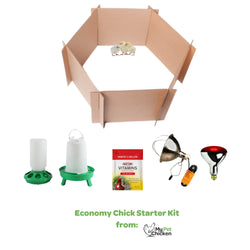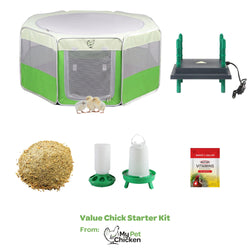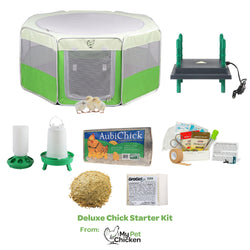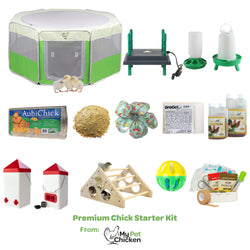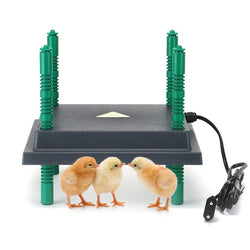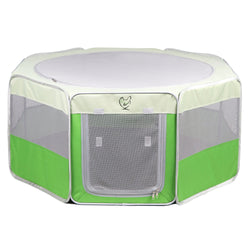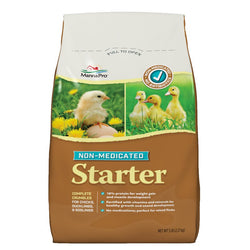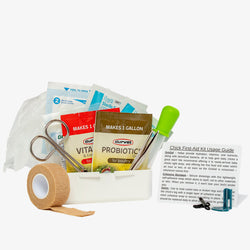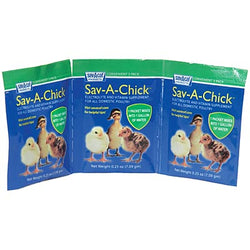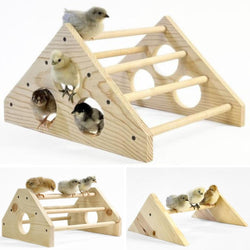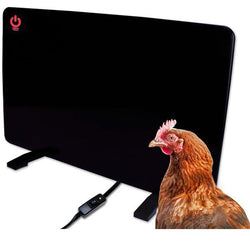What are Scaly Leg Mites in Chickens?
Back to blog
Are your chicken's legs looking rough and they can't seem to stop scratching? They could be suffering from a scaly leg mite infestation. These minuscule parasites, known scientifically as Knemidocoptes mutans, burrow under a chicken's leg scales and can cause some serious discomfort and potential health risks if not treated.
Scaly leg mites, quite literally, take up residence under the scales on a chicken's legs and feet. Once settled, they feast upon the keratin present in these scales, causing them to lift and detach from the skin. This infestation triggers various symptoms in your chicken, including constant itching, swelling, and in bad cases, could lead to lameness.
Dealing with a scaly leg mite infection requires patience and regular treatment. The usual course involves applying a safe, mite-killing product on the affected chicken's legs. This process is typically repeated every seven days until the infection clears up. It's essential to repeat the treatment even after the obvious signs of mites have disappeared, to be sure all mites and (including un-hatched ones) are killed. On top of treating the infestation, maintaining a clean, sanitary coop can minimize the chances of scaly leg mites recurring.

Treatment Methods for Scaly Leg Mites
Scaly leg mites can be effectively treated with various methods aimed at suffocating and removing the mites, as well as promoting healing and preventing further infestations. Here are some common treatment options:
1. Topical Ointments and Oils
- Petroleum Jelly: Applying petroleum jelly or mineral oil to the affected legs and feet suffocates the mites and helps soften the scales, making them easier to remove.
- Cooking Oil: Vegetable or olive oil can also be applied to the legs to smother the mites.
- Commercial Mite Creams: There are over-the-counter creams formulated specifically to treat scaly leg mites. These often contain ingredients that help eradicate the mites and soothe the affected skin.
For all topical treatments apply daily until the old damaged scales have fallen off and healthy new scales have grown in.
2. Soaking and Cleaning
- Soak the Legs: Gently soak the chicken's legs and feet in warm, soapy water for about 15-20 minutes. This helps soften the scales and makes them easier to remove.
- Soft Brushing: After soaking, use a soft toothbrush or nail brush to gently scrub the legs, removing dead scales and mites. Be careful not to cause any discomfort to the chicken. Using soaking and cleaning in combination with topical treatments to remove the dead scales and debris 1 to 2 times a week.
3. Permethrin Dust
- Permethrin dust is a common insecticide used to treat mite infestations. Dust the affected areas and perches with the recommended amount of permethrin, following the product instructions.
4. Isolation and Preventive Measures
- Isolate Infected Birds: Isolate birds with severe infestations to prevent the spread of mites to other flock members.
- Sanitize the Coop: Thoroughly clean and disinfect the coop, including perches and roosts, to eliminate any remaining mites or eggs.
5. Natural Remedies
- Herbs and Essential Oils: Some chicken keepers use herbal remedies or essential oils like neem, lavender, or tea tree oil to repel mites. Use caution and ensure the chosen remedy is safe for chickens.
Keep in mind that treating scaly leg mites can take multiple applications over time. Be both patient and persistent. Should the infestation become severe or resist home remedies, get advice from a vet experienced in poultry care. Taking preventative actions like maintaining a clean coop, providing dust baths, and good sanitation practices aids in reducing future invasions.
Keep a Clean Coop to Help Prevent Scaly Leg Mites
A tidy, well-kept coop is crucial, acting as a frontline defense against numerous health problems, such as scaly leg mites. These tiny pests thrive in unclean and dirty environments, making proactive cleaning a key strategy for prevention. Check out our coop cleaning supplies for sale to help you maintain the best environment possible for your backyard flock!
Conditions that Favor Scaly Leg Mites:
Scaly leg mites flourish and reproduce most effectively under specific circumstances. They thrive in environments characterized by dampness and high humidity, finding ideal habitats in coops with inadequate ventilation, leaky roofs, or damp bedding. The presence of accumulated droppings, dirt, and debris creates a fertile breeding ground for these pests, underscoring the importance of consistent cleaning and effective waste management. Crowded coops can exacerbate mite transmission due to heightened chicken contact, emphasizing the need for sufficient space to minimize stress and diminish the potential for mite spread.
Best Practices for Maintaining a Scaly Leg Mite Free Coop
Incorporating proper waste management is vital. Regularly clear droppings and debris from the coop's floor and run area, preventing a breeding ground for mites. Installing dropping boards beneath roosts can simplify waste removal and minimize mites' access to droppings.
Ventilation plays a crucial role in preventing dampness, another condition that favors mite proliferation. Ensure your coop is adequately ventilated to keep moisture levels in check. Regularly inspect the coop for any leaks or areas where moisture might be seeping in, and promptly address these issues to maintain a dry environment.
Creating a designated area for dust baths within the coop is an excellent preventative measure. A dust bath helps chickens naturally control external parasites, including mites. Fill this area with fine sand, dirt, and wood ash, which provide chickens with the materials they need to engage in dusting behaviors that help deter mites.
Most importantly you should institute a consistent cleaning schedule that encompasses daily, weekly, and monthly tasks to keep your coop fresh and pest free and ensure the health of your flock! Here's a detailed task list to guide you:
Daily Tasks
- Bedding Check: Remove soiled bedding from the coop floor and nesting boxes daily. Replace with fresh, clean bedding to keep moisture levels low and discourage mites.
- Droppings Removal: Regularly clear droppings from coop surfaces, perches, and nesting areas. Dispose of droppings properly to hinder nite breeding.
Weekly Tasks
- Thorough Cleaning: Empty and clean the coop interior on a weekly basis. Scrub surfaces, including roosts and nesting boxes, using a mild detergent to eliminate mite hiding spots.
- Ventilation Check: Check the coop's ventilation system for proper airflow. Ensure vents are unobstructed to prevent excess humidity that mites thrive in.
- Dust Bath Area Maintenance: If applicable, refresh the dust bath area with clean sand, dirt, and wood ash. This aids in natural mite prevention.
Monthly Tasks
- Nest Box Overhaul: Remove all bedding from nesting boxes and replace it with fresh material. Cleaning nesting areas minimizes mite habitats.
- Floor Deep Cleaning: Conduct a more thorough floor cleaning once a month. Remove all bedding, clean, and sanitize the coop floor to deter mites.
The adage "prevention is better than cure" couldn't be truer when it comes to safeguarding your flock from the scourge of scaly leg mites. A clean coop isn't just a matter of aesthetics—it's a fortress against a host of health woes. By diligently implementing a structured cleaning routine encompassing daily, weekly, and monthly tasks, you'll not only create an environment that actively deters mites but also ensure the overall health and happiness of your beloved chickens.
By staying informed, taking prompt action, and implementing a comprehensive cleaning routine, you're actively protecting your flock's health and well-being. Your commitment to their care will lead to happy, healthy chickens enjoying a mite-free environment and the best quality of life possible.
